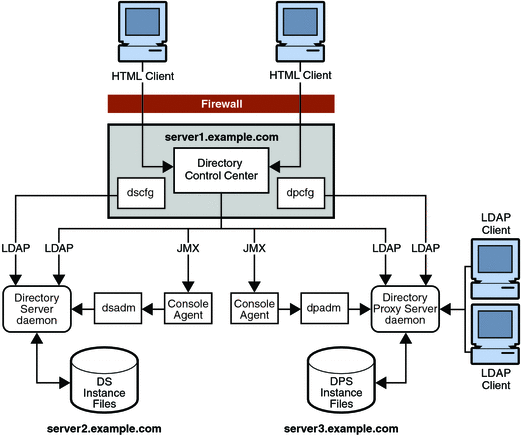Directory Server Enterprise Edition Administration Model
Directory Server Enterprise Edition gives the administrator more control over instance creation and administration. This control is achieved by using two new commands, dsadm and dsconf. These commands provide all the functionality previously supplied by the directoryserver command plus additional functionality.
The dsadm command enables the administrator to create, start, and stop a Directory Server instance. This command combines all operations that require file system access to the Directory Server instance. The command must be run on the machine that hosts the instance. It does not perform any operation that requires LDAP access to the instance or access to an agent.
In the new administration model, a Directory Server instance is no longer tied to a ServerRoot. Each Directory Server instance is a standalone directory that can be manipulated in the same manner as an ordinary standalone directory.
The dsconf command combines the administration operations that require write access to cn=config. The dsconf command is an LDAP client. It can only be executed on an active Directory Server instance. The command can be run remotely, enabling administrators to configure multiple instances from a single remote machine.
Directory Proxy Server provides two comparable commands, dpadm and dpconf. The dpadm command enables the administrator to create, start, and stop a Directory Proxy Server instance. The dpconf command enables the administrator to configure Directory Proxy Server by using LDAP and to access the Directory Server configuration through Directory Proxy Server.
In addition to these command-line utilities, Directory Server Enterprise Edition is integrated into the Java Web Console. The Console enables Directory Server Enterprise Edition and other Sun products to be managed from a centralized user interface. Directory Service Control Center (DSCC) is a service of the Java Web Console that is specifically for managing Directory Servers and Directory Proxy Servers. DSCC provides the same functionality as the command-line utilities, as well as wizards that enable you to configure several servers simultaneously. In addition, DSCC provides a replication topology drawing tool that enables you to monitor replication topologies graphically. This tool simplifies replication monitoring by providing a real-time view of individual masters, hubs, and consumers, and the replication agreements between them.
Remote Administration
The Directory Server Enterprise Edition administration model, described in the previous section, also enables remote administration of any Directory Server or Directory Proxy Server in the topology. Servers can be administered remotely using both the command-line utilities and the Java Web Console.
The dsadm and dpadm utilities cannot be run remotely. These utilities must be installed and run on the same machine as the server instance that is being administered. For details of the functionality provided with dsadm and dpadm, see the dsadm(1M) and dpadm(1M) man pages.
The dsconf and dpconf utilities can be run remotely. For details of the functionality provided with dsconf and dpconf, see the dsconf(1M) and dpconf(1M) man pages.
The following figure illustrates how the new administration model facilitates remote administration. This illustration shows that the console and configuration commands can be installed and run remotely from the Directory Server and Directory Proxy Server instances. The administration commands must be run locally to the instances.
Figure 8–1 Directory Server Enterprise Edition Administration Model

- © 2010, Oracle Corporation and/or its affiliates
